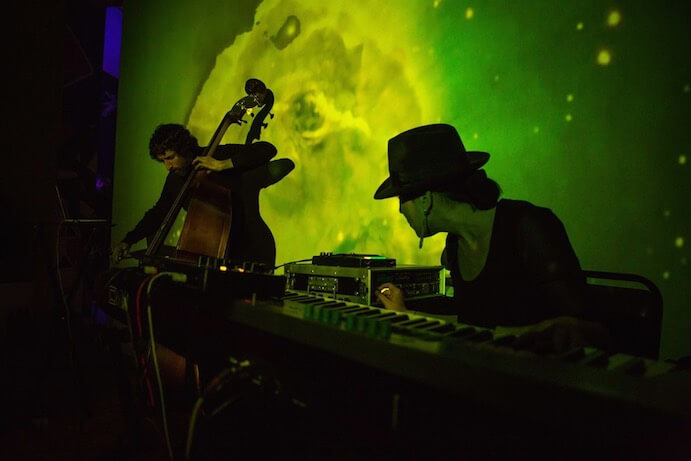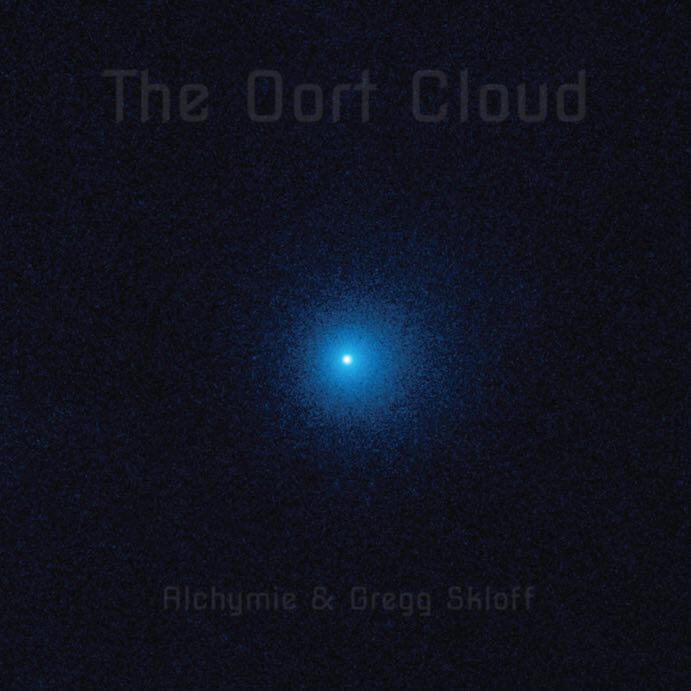In the 1950s, Jan Oort hypothesized the existence of a huge collection of icy interstellar debris on the very outer limits of the Sun’s gravitational field, which occasionally kicks objects—that we know and love as comets—into our solar system. This monolithic cloud is the namesake of Alchymie (Jennifer Ruzicka, keyboards) and Gregg Skloff’s (contrabass) ambient drone album, The Oort Cloud, five tracks taken from their debut public performance in Waterford, Ireland as part of the fifth Sonic Dreams Festival. Released on Aerocade Music, this excursion through noisy electronic landscapes of thick bass rumbles and phaser-heavy synths presents all the materials of enticing industrial drone music, but skirts the line between the genre’s requisite minimalist bombardment and a simple lack of appropriate development.
The sonic vocabulary of The Oort Cloud is fairly expansive—the opening of “Planet 9 (The Perturber)” introduces a recurrent soundscape of articulated bass notes being manipulated for their overtone potential, with added ornaments of noise and distortion to frame the space. We soon hear screeching metallic tones, air noises fed through various filters, and rich synth textures, all of which are constantly cycling in and out of focus with one another overtop the persistent bass droning.
These sounds are complex, in the spectral sense—any individual piece of material is a new possible trajectory to be explored by filters or wave interference, and the album is at its best when it lets these sounds fully evolve into those potentials. The gritty bass drone and fuzzy, meandering melody of “K2 (Beyond Crystallization)” organically move through a series of textural iterations, the development of which is clearly traceable from their opening statements to the end. This is especially true of the melody, which strongly resembles an electric guitar and artfully moves in and out of a large variety of registral, textural, and harmonic functions.

Gregg Skloff and Alchymie–Photo by Max Ott
Similarly, the contrast between the drone and the dark keyboard accompaniment in both “Hyakutake” and “Sedna’s Sister (In Red)” works extremely well, balancing each other out as they each reach further into their high range and overtones. “Sedna’s Sister” stands out in particular; every sound is given its requisite space to expand, and new sounds clearly emerge from the material preceding.
Despite the efficacy of these ideas, however, the tracks suffer from an over-saturation of ideas, and it takes an extra degree of attention to recognize these slow-developing processes. The fascinating ambience of “K2” is masked by a periodic, texturally untethered noise-sweep that permeates the background for over 6 of the 10 minutes of music, which creates a regrettable sense of pulse and disappears just as innocuously as it seemed to be present. Similar problems manifest on most of the tracks, where a fascinating idea is introduced and we begin to hear its timbral and textural possibilities, just for the introduction of another complex sound to force the ongoing idea to the background.
This could be an aesthetic choice to create a sense of ambience through saturation. However, the effect is nevertheless a homogeneity that glosses over the tracks on a full-album listen. So many similar sounds are used so often that they either lose their interest and/or become a cliché in later tracks; the clearest perpetrator of this is the filter sweep mentioned above. This is not helped by the fact that the form of each track is virtually the same, with a droning introduction, quick addition of material, a sustain of this texture for most of the track, and then an abrupt drop-off of material and fade out to close.
Part of these issues may stem from the fact that the tracks on The Oort Cloud are all taken from a live performance; the duo’s earlier studio recorded album, The Kuiper Belt, is much more balanced in its development of similar sounds. Perhaps a single evening-length set combining these ideas would have been more effective, allowing more exploration of certain sounds while eliminating the problem of overuse across tracks. In this recording, we are also, crucially, missing the VJ set by MarQu Vr that accompanied the live performance; for a taste of that, you can check out the additional video created for “Oumuamua” (above).
Alchymie and Skloff clearly have a keen ear for complex sounds and how to exploit them—no arguing that. Where The Oort Cloud falters is deployment, a problem that might simply indicate a need to rethink their sonic universe for a live performance situation. As it stands, their ambient textures overwhelm through a process of addition rather than expansion, which strikes me as the less effective of the two; their sounds could, ironically, benefit from a bit more space.





















